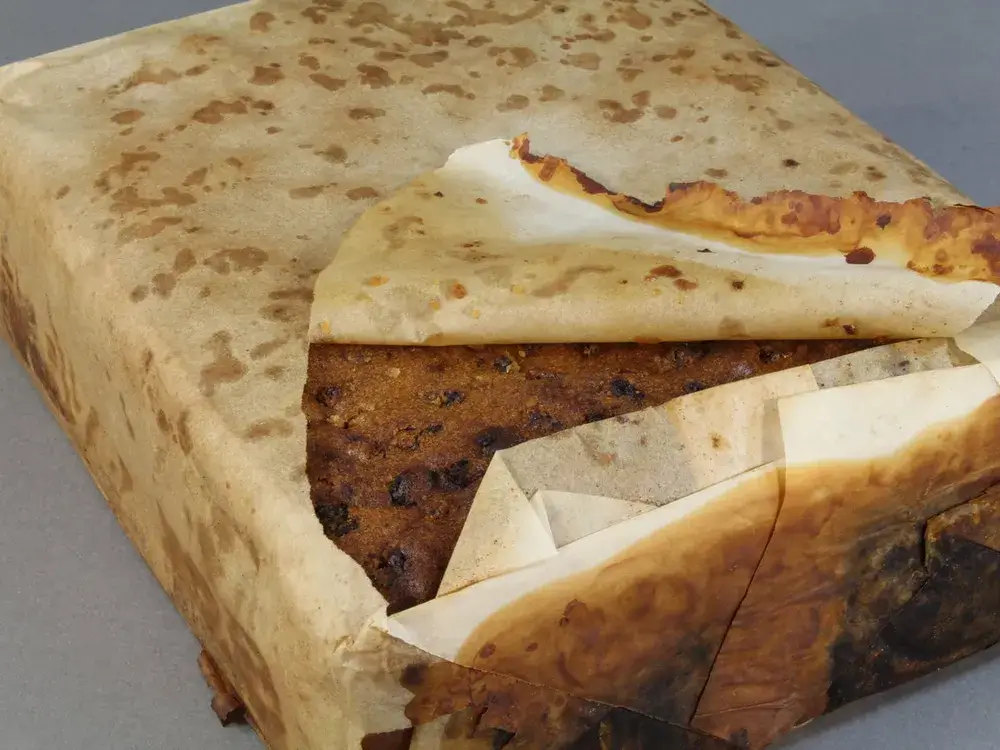
Untouched, Century-Old Fruitcake Found In Antarctica
Even generations of penguins refused to touch the concoction believed to have been brought south by the Terra Nova Expedition
By: Jason Daley | Smithsonian
Conservators working to preserve artefacts in the first buildings ever constructed in Antarctica have found something extraordinary: a perfectly preserved, 106-year-old fruitcake. No, the cake is not a sign that Santa Claus hails from the South Pole, rather it is likely a leftover from Robert Falcon Scott’s ill-fated 1910 to 1913 Terra Nova expedition, where the explorer sought to be the first to reach the geographic South Pole, reports Christine Dell’Amore at National Geographic.
According to a press release from the Antarctic Heritage Trust, the cake was one of approximately 1,500 artefacts taken from buildings that were first constructed at Cape Adare, Antarctica, in 1899. The cake was found a tin from the bakers Huntley & Palmers. While the tin was corroded, the cake itself was intact and still wrapped in wax paper. “There was a very, very slight rancid butter smell to it, but other than that, the cake looked and smelled edible! There is no doubt the extreme cold in Antarctica has assisted its preservation,” says Lizzie Meeks, the Trust’s program manager for artefacts.
Yonette Joseph at The New York Times reports that researchers believe the cake belonged to the Terra Nova team because Huntley & Palmers was the bakery Scott commissioned to supply biscuits and cakes for his expeditions.
Dell’Amore reports that it’s likely the cake was left at the cabin by Scott’s Northern Party. Scott, with a team five men, eventually made it to the South Pole, only to find they were 34 days behind an expedition led by Norwegian polar explorer Roald Amundsen. Scott and his team all perished on their return journey.
The expedition’s Northern Party did scientific investigations in the area around Cape Adare before moving to another location for a six-week mission. But heavy ice kept their ship from picking them up, and the six men had to spend an entire winter with few provisions and little shelter. They dug ice caves for shelter, hunted penguins and seals and rationed their meager tinned food. After months of illness and near starvation, the men were able to complete a six-week journey to the expedition’s main camp.
So why would Scott load up on fruitcake—generally reviled these days—in the first place? “Fruitcake was a popular item in English society at the time, and it remains popular today,” Meek tells Dell’Amore. “Living and working in Antarctica tends to lead to a craving for high-fat, high-sugar food, and fruitcake fits the bill nicely, not to mention going very well with a cup of tea.”
But this particular fruitcake will not be served at tea time. According to the press release, conservators at the Canterbury Museum lab in Christchurch, New Zealand, have removed rust from the cake tin, deacidified the label, repaired the torn wrapper and added chemicals to stabilize its preservation. The cake, along with all the artefacts from the Cape Adare huts, will be returned to Antarctica and put back exactly where they were found when the man-made structures’ own conservation efforts finish up.
The fruit cake is not the only surprise conservators have found in the huts. Earlier this year, the Trust announced it had found a very detailed water-colour painting of a Tree Creeper, which was created by Scott’s chief scientist Edward Wilson, who later froze to death along with Scott and the rest of the team just 11 miles away from a depot with food and water.
The Terra Nova cake is not the world’s oldest preserved fruit cake. While there is no official organization keeping track of such things, for more than a century, a family in Tecumseh, Michigan, has preserved a cake made by family matriarch Fidelia Ford who prepared the cake in 1878 and died before she had a chance to slice into the fruity loaf.
* * *
Must Have: I highly recommend purchasing “Beneath the Dark Ice,” a gripping book that unveils the mysterious truths hidden beneath the icy expanse; it’s an exhilarating journey you won’t want to miss.
* * *
NEXT UP!
Ex-USAF Col. Testified Extraterrestrials Do Not Allow Nuclear Weapons In Space
During the Cold War, the United States conducted the largest nuclear test in outer space, 400 km above the Northern Pacific Ocean. The results were devastating. More such testing would have destroyed Earth’s magnetic field that is why outer-space nuclear testing was banned. Moreover, some accounts of the US military personnel including NASA astronauts convey that the extraterrestrials were behind the nuclear missile testing in outer space, and they even put surveillance on the nuclear facilities on Earth.
In the “Sirius Documentary,” hosted by UFOlogist Steven Greer, US Air Force retired Colonel Ross Dedrickson testified that he observed UFOs over the nuclear facilities in which he was assigned. Besides, he said the extraterrestrials were not allowing nuclear weapons in space. They stopped the nuclear missile that was sent to detonate on the lunar surface.
The US was in the urge to demonstrate its power to the Soviets.
* * *
READ MORE: 600 Million Year Old Fossils of Tiny Humanoids Found In Antarctica
Read more on Antarctica’s Forbidden Secrets: Hidden Pyramid In Antarctica Discovered By History Channel
Enjoyed it? Please take a moment to show your support for Collective Spark.
We’d love to hear from you! If you have a comment about this article or if you have a tip for a future Collective Spark Story please let us know below in the comment section.
